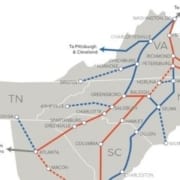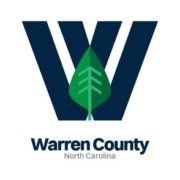Plans for the proposed S-Line are chugging along, and Vance County commissioners got an encouraging update from NC DOT officials at their meeting earlier this week.
If all goes the way it’s supposed to, Henderson and Norlina will be stops along a yet-to-be completed passenger rail line that will connect the Washington, D.C. and the Northeast Corridor rail system all the way to Florida.
Julie White, deputy secretary for multi-modal transportation with DOT, joined Rail Division Director Jason Orthner and Ryan Brumfield, DOT’s integrated mobility division director at Monday’s meeting.
“We continue to see support of the corridor and interest from the U.S. DOT to invest,” Orthner stated.
This stretch of rail line that includes seven stops from Sanford to Norlina in North Carolina, is expected to serve up to 25 million passengers when it’s completed, sometime close to 2030. It will connect Raleigh and Richmond, VA.
Grant funding provided $950,000 for conduct studies for each of the proposed stops in Henderson and Norlina. There were multiple listening sessions in each area to gather community input and explain the project over the course of the past year or so.
The two local stops proposed in this stretch of the S-Line project are among seven, with others being Sanford, Apex, Wake Forest, Youngsville and Franklinton.
Ridership in North Carolina has increased steadily over the past five years, with the exception of 2020 when COVID-19 was in full force. In 2022, more than a half million people hopped on a train to get from Point A to Point B, according to information the trio shared with commissioners.
People are leaning into rail for transportation needs, Orthner noted. A fifth train is being added to serve the Raleigh to Charlotte market and this year roundtrip service between the two major urban areas is scheduled to begin.
The impact on the local economy could be big, and local leaders have been involved in discussions about potential station, or hub, sites in recent months as plans continue to progress.
This project has been in process since the early 1990’s and the corridor rail was acquired from CSX in 2020. Since then, there have been lots of studies and grant awards to keep the whole thing “on track,” no pun intended.
Brumfield said the community interest in creating the rail service has added to the success of the project. The creation of “mobility hubs” involves much more that a building where people wait to board a train, he said. It’s an activity center of transportation and a meeting space where energy ripples out into the wider community, positively affecting quality of life and accessibility and making communities more vibrant.
Commissioners asked questions, from length of time to get from Raleigh to Richmond (2 -2.5 hours) to what type of train traffic Henderson could expect to see along its portion of the rail line (continued freight service and faster passenger service).
Right now, CSX runs trains about 25 mph in the area, but high-speed service means that passenger trains could reach between 80 and 110 mph on northbound and southbound runs.
This project is one of 10 that the NC DOT Rail Division has across the state.
In their presentation to commissioners, the DOT team noted that this construction project will result in one of the most technologically advanced railroads in the Southeast, providing:
-110 mph passenger railroad
-91 new grade separations
-concrete ties
-high speed switches
-high level platforms
-freight bypass tracks
-positive train control and
-advanced signal systems
Once the Raleigh to Richmond link is completed, it will connect North Carolina and points farther South to Washington, DC and points up the Northeast Corridor, where rail service is a critical transportation component for commuters and other travelers.
Benefits to our region include:
- Direct connection between urban centers by as many as 25 million passengers by 2040
- Additional capacity and over and hour in travel time saved between NC and VA
- Backbone of regional multi-modal connectivity including commuter rail, transit and active transportation
- Critical to further expanding the NC passenger rail system
- Provides freight network resiliency
- Environmental benefits
- Expands service to disadvantaged and underserved regions
WHAT’S NEXT:
- Prepare and submit grant applications. There’s a grant funding match provided by the State Transportation Improvement Plan would combine local funding with state and federal grants. Application due April 21.
- Develop and implement the first phase of the S-Line will be Raleigh to Wake Forest
- There’s $4.5 billion available from 2022 FRA (a federal-state partnership)
- Grant funding for ROW, final design and constructions.
CLICK PLAY!




